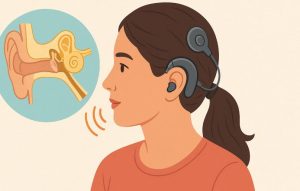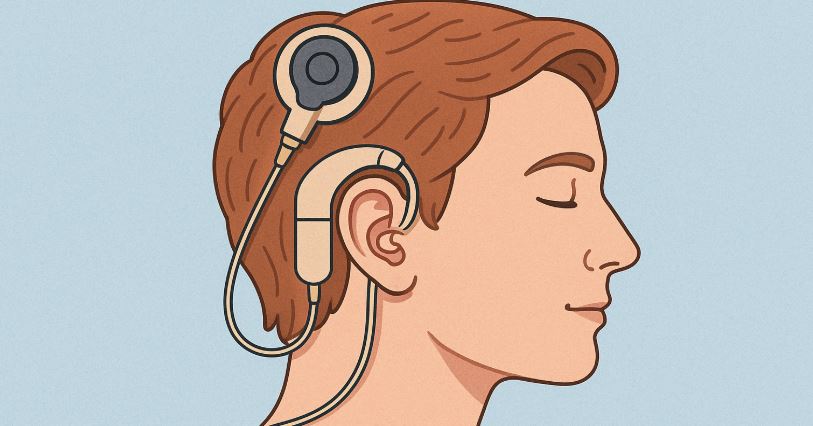Why Cochlear Implants Are Bad?
According to the Centers for Disease Control and Prevention (CDC), approximately 2 to 3 out of every 1,000 children are born with some level of hearing loss, while around 13% of people aged 12 and over experience hearing loss in both ears.
In the UK, similar figures point to thousands of children and adults navigating the challenges of hearing impairment. With numbers like these, it’s no surprise that cochlear implants are widely promoted as a medical breakthrough, a solution for those who struggle with severe to profound hearing loss.
However, while cochlear implants have transformed lives and restored a sense of sound for many, they are far from a perfect solution.
Beneath the surface of compelling success stories and emotional social media clips lies a complex web of risks, controversies, side effects, and ethical debates.
For every person who benefits from the technology, there are others who face surgical complications, sensory confusion, or a cultural and emotional disconnection.
In this guide, we’ll explore why cochlear implants are bad, or at least, why they’re not always the miracle solution they appear to be.
From medical limitations and device risks to cultural opposition and social stigma, this article aims to offer a balanced and in-depth understanding of the realities behind cochlear implant use.
What Are Cochlear Implants and How Do They Work?

Cochlear implants are medical devices developed to assist individuals with severe to profound hearing loss when traditional hearing aids are ineffective.
They function by converting sound into electrical signals that directly stimulate the auditory nerve. This signal bypasses damaged portions of the ear and provides the brain with a new way to perceive sound.
The device comprises two main components. The internal part is surgically implanted under the skin behind the ear and includes an electrode array that is inserted into the cochlea.
The external part, worn like a hearing aid, contains a microphone, speech processor, and transmitter. These components work together to detect sound, process it, and send it to the internal component for neural transmission.
Unlike hearing aids, cochlear implants do not simply make sounds louder. They convert acoustic information into electrical pulses, which the brain learns to interpret as sound. While this mechanism has helped many access sound in some form, it is far from perfect and comes with numerous limitations and controversies.
What Are the Disadvantages of Cochlear Implants?
Cochlear implants are often viewed as modern marvels of medicine, but they come with a host of drawbacks. These disadvantages may not always be apparent at first and can emerge over time or as part of the adjustment process.
Surgical and Medical Risks
The surgical procedure to implant the device is invasive and carries the standard risks associated with general anaesthesia. These include potential allergic reactions, respiratory complications, and cardiovascular issues, particularly for individuals with pre-existing medical conditions.
Injury to the facial nerve during surgery is another concern. This nerve runs close to the middle ear and is at risk of damage during implantation. Such an injury may lead to temporary or permanent facial weakness or paralysis.
Other risks include:
- Meningitis: a rare but serious infection of the brain’s protective membranes, more likely in individuals with abnormally formed inner ear structures.
- Perilymph or cerebrospinal fluid leaks: caused by damage to inner ear membranes.
- Infections: at the surgical site, leading to further complications.
- Tinnitus, dizziness, or vertigo: all reported as side effects post-surgery.
In rare cases, reparative granulomas may form if the body treats the implant as a foreign object and triggers an inflammatory response.
Technological Limitations
The device’s internal parts are meant to last a lifetime, but the external components may need frequent updates or replacements. Over time, compatibility with future technologies is not guaranteed. This means users may have to undergo additional surgeries if their implant becomes obsolete or faulty.
In cases of device failure, reimplantation becomes necessary, exposing the individual to further surgical risks and emotional distress. Some users also report that their second implant performs worse than the first, which can diminish the perceived success of the intervention.
What Side Effects and Long-Term Issues Are Linked to Cochlear Implants?
Sensory and Functional Side Effects
Short-term side effects often include numbness, discomfort, and sensitivity around the implant site. Users may also experience altered taste due to nerve disruption during surgery. Dizziness and balance issues can be persistent for some, affecting daily movement and activities.
Long-term, individuals may suffer from:
- Persistent tinnitus: a constant ringing or buzzing in the ear, which can lead to fatigue, stress, or insomnia.
- Dependence on device functionality: If the battery dies or the external unit is damaged, the user may temporarily lose access to sound.
Cochlear implants also demand strict lifestyle changes. For example, users must avoid water contact with the external unit, making swimming, bathing, and other water-based activities challenging unless they invest in water-safe accessories, which can be costly.
Why Is Sound Quality a Concern with Cochlear Implants?

Sound quality delivered by cochlear implants is vastly different from natural hearing. While recipients can perceive a range of environmental noises and speech, they often describe these sounds as artificial or robotic.
Perception Challenges
In quiet settings, speech recognition may be acceptable. However, noisy environments pose significant challenges. Background noise can overwhelm speech signals, making communication difficult in restaurants, public transport, or group conversations.
Users often struggle with:
- Differentiating musical tones or recognising instruments
- Identifying subtle changes in pitch or tone
- Understanding voices over the phone, particularly unfamiliar ones
Even after years of use, many recipients still rely on visual cues, such as lip-reading and body language, to fully understand speech. For some, the effort to process sound can lead to cognitive fatigue or sensory overload.
What Are the Ethical and Social Controversies Around Cochlear Implants?
Beyond the medical complexities, cochlear implants stir heated debate within both the medical and Deaf communities. At the heart of the controversy is the question: Should deafness be treated as a condition that needs to be fixed?
Deaf Culture and Identity
To many in the Deaf community, deafness is not a disability but a unique cultural identity. The widespread promotion of cochlear implants is often seen as an attempt to “normalise” deaf individuals, thereby undermining sign language and Deaf culture.
Ableism and Autonomy
Critics argue that cochlear implants perpetuate a form of ableism known as “audism”, the belief that being able to hear is inherently superior. The assumption that deaf people need to be “fixed” rather than accommodated reflects societal bias.
The ethical dilemma intensifies when it involves children. Since they cannot provide informed consent, implanting them early in life may deprive them of the opportunity to embrace Deaf culture. It raises important questions about autonomy and parental decision-making.
How Do Cochlear Implants Compare to Other Hearing Loss Treatments?
Hearing Aids vs Cochlear Implants
Hearing aids are non-invasive, easy to manage, and suitable for mild to moderate hearing loss. They amplify sound but do not interfere with the natural anatomy of the ear.
In contrast, cochlear implants are best suited for individuals who derive little or no benefit from hearing aids. However, they require surgery, consistent maintenance, and post-operative auditory training to interpret the digital signals.
Other Alternatives
- Bone-Anchored Hearing Devices: Ideal for individuals with conductive or single-sided hearing loss.
- Assistive Listening Devices: These include captioning services, FM systems, and visual alerts for sounds like doorbells or alarms.
- Auditory Training and Speech Therapy: Effective for enhancing residual hearing and speech understanding without surgery.
Who Should Think Twice Before Choosing Cochlear Implants?

Cochlear implants are not universally beneficial. The decision must be tailored to individual needs and circumstances.
Considerations for Different Groups
- Children: The pressure on parents to make a quick decision can lead to choices that are misaligned with the child’s long-term identity or preferences.
- Elderly: Older adults may not experience the same level of benefit due to age-related neural decline and may face heightened surgical risks.
- People with Partial Hearing: Implanting may erase usable natural hearing.
- Individuals with Medical Conditions: Certain health issues can increase the risks associated with surgery and anaesthesia.
- Those with Mental Health Concerns: The adjustment process can be emotionally taxing and may worsen existing mental health conditions.
What Are the Pros and Cons of Cochlear Implants?
| Pros | Cons |
| Access to environmental sounds and speech | Surgical risks including infection and nerve damage |
| Improved communication in quiet settings | Requires long-term training and rehabilitation |
| Supports child language development when implanted early | Loss of any remaining natural hearing in the implanted ear |
| Increased independence for adults with severe hearing loss | Sound perception may remain artificial or unclear |
| Can reduce reliance on visual communication tools | Expensive maintenance and need for device replacements/upgrades |
| Compatible with newer tech in some cases | Interference with MRIs, security systems, and electronic environments |
What Do Experts and Real Users Say About Cochlear Implants?
Clinical Studies and Statistics
According to a 2020 systematic review of 102 studies, adult users of cochlear implants improved their word recognition ability by an average of 21.5%. The outcome, however, varies based on the type of hearing loss:
- Post-lingual adults: 82% reported at least 15% improvement
- Pre-lingual adults: Only 53.4% experienced similar improvements
These findings underscore the importance of individual factors, such as the age at onset of hearing loss and time of implantation, in predicting success.
Real User Feedback
User experiences vary significantly. Some express life-changing improvements, particularly in communication and social engagement. Others describe feeling disconnected from both the Deaf and hearing communities, finding themselves in a liminal space that satisfies neither identity.
Adjusting to sound perception takes time, sometimes years. Initial excitement can give way to frustration if expectations are not met or if users feel misled by overly optimistic portrayals in the media.
What Should Be Considered Before Getting a Cochlear Implant?

Before opting for a cochlear implant, thorough evaluation and education are essential.
- Medical Assessment: Includes hearing tests, imaging, and consultations with ENT specialists and audiologists.
- Psychological Evaluation: To assess emotional readiness and resilience.
- Informed Consent: Particularly important for children and vulnerable adults.
- Financial Planning: Covers not just the procedure, but ongoing device maintenance, upgrades, batteries, and accessories.
- Understanding Lifestyle Adjustments: Including avoiding water damage, static electricity, and interference from electronic fields.
FAQs
Can cochlear implants completely restore hearing?
No, cochlear implants offer a simulated form of hearing that differs from natural sound. While it helps many understand speech, it does not restore hearing to normal.
What are the major surgical risks of cochlear implants?
These include infection, facial nerve injury, meningitis, fluid leaks, and permanent hearing loss in the implanted ear.
Who benefits most from cochlear implants?
Typically, individuals with profound hearing loss who receive minimal benefit from hearing aids, especially those who lost hearing after learning to speak, show the most significant improvement.
Yes. Many in the Deaf community view cochlear implants as diminishing their cultural identity and promoting ableism.
How do users describe the sound quality of cochlear implants?
Many describe the sound as mechanical or robotic, especially in the initial phase. Some adjust over time, while others continue to struggle with clarity.
Are cochlear implants suitable for young children?
They can be, particularly for language development. However, the decision is ethically complex and should involve discussions with healthcare providers and cultural sensitivity.
Can cochlear implants fail?
Yes. Device failure can occur, though rare, and may require additional surgery. Maintenance is essential, and technological obsolescence is a concern.







